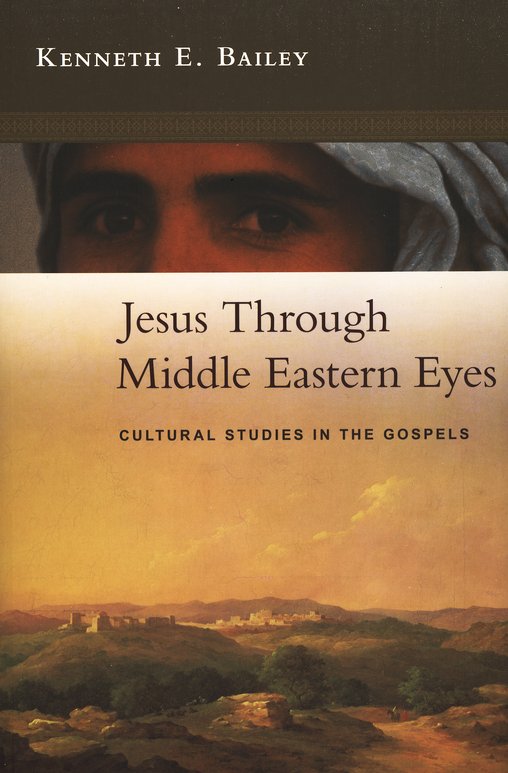Kenneth Bailey's "Jesus Through Middle-Eastern Eyes: Cultural Studies in the Gospels" is the most stimulating and helpful Biblical Studies book I have read for quite some time. After an introduction which lays out his framework and introduces the reader to his main lines of argument and hermeneutical tools, the book consists of 32 essays on aspects of the life and teaching of Jesus Christ as depicted in the synoptic gospels. When I was given this book I assumed that the "Middle Eastern Eyes" in question belonged to Kenneth Bailey himself, and presented his insights from a lifetime living in the Middle East to help western readers more accurately grasp the message of the gospels. This is certainly the case, and in many occasions his cultural insights add huge depth to his interpretations of incidents and parables which simply would not occur to the western reader. In several cases these insights are extraordinarily helpful in 'un-knotting' the theological problems in texts usually viewed as problematic; when the the real problem is an assumption which we have brought to the text which would have been entirely alien to Jesus' first hearers or the gospel writers. However the "Middle Eastern Eyes" with which Bailey addresses his subject are not restricted to his own two; but include his lifetime's research into Middle Eastern languages (Aramaic, Syriac, Arabic etc ), and the deep wells of two millennia of Bible study, reflection and commentary in those tongues which are inaccessible to the ordinary reader. These provide a wealth of useful and sometimes startling quotations with which to furnish his argument, or add illustrations as to how the cultural phenomena he describes function in ordinary life in the Middle East.
There are over four hundred pages in Bailey's book, but one example will provide an illustration of the added depth these cultural studies provide to our reading. I have read the 'parable of the rich fool' in Luke 12 many times. I had never before noticed the phrase 'he thought to himself' which Bailey says is literally rendered 'he discussed with himself'. Bailey demonstrates that in Middle Eastern culture important financial decisions and forward-planning is never conducted alone, but always with family, friends and respected others. This self-discussion seems unremarkable to the western reader reared on a diet of extreme individualism; but the rich man in the parable is to be pictured as having been alienated from everyone around him by his love of money. Not only will he be cut off from God by his idolatry; but we are also meant to picture him in an unnatural isolation, building a wall to protect his cash, which becomes a wall of separation cutting him off from real life. Accessing the cultural context transforms a throwaway phrase into a vivid picture of the alienation which unchecked sin causes.
Another major feature of the book is Bailey's structural analysis of the various pericopes from which the gospels were constructed. He demonstrates with diagrams, the way in which the segments of the gospels (especially the sayings of Christ, from Beatitudes to Parables) are not merely homespun peasant tales with obvious meanings; but are finely crafted poetic units built in the old Hebrew tradition of cycles of paired sayings. He points out that in many of these units the Greek (and Western logical tradition) emphasises the final clause of a literary unit as the conclusion to which all other material leads up. However to read Jesus' parables in this way is to place the central meaning in different place than was originally ever intended. So for instance, the 'bookends' of a unit which start and end it might be significant, but the very central stanza might be the main point, but comes wrapped in symmetrical clauses.
Bailey's handling of the birth of Christ narratives in fascinating and illuminating, his explorations of The Beatitudes and 'Lord's Prayer' are very helpful, as are his essays on the miracles of Jesus and Jesus' treatment of women. It was the final section on the parables which I think I found the most surprising and illuminating though. One of the enduring benefits of this book for me will be Bailey's repeated demonstration of the fact that the oft-perceived theological gap between Jesus and Paul, is less problematic than the Western reader is sometimes tempted to think. In Bailey's contextural cultural analysis of the words of Christ, an enormously strong doctrine of grace emerges which coheres with the work which the Apostle Paul would subsequently produce for gentile believers.
Bailey has the ability to express a huge weight of scholarship in quite plain language, not expecting the reader to share his access to technical theological language, let alone be multi-lingual in tongues both living and dead! Not only does he do the reader the service of writing profoundly and deeply, but he also provides bullet-pointed summaries at the end of the chapter to enable easy recollection of the main points made.
This is tremendous reading, and a book to which I know I will return again and again when I read, or discuss or preach on these gospel texts.


No comments:
Post a Comment